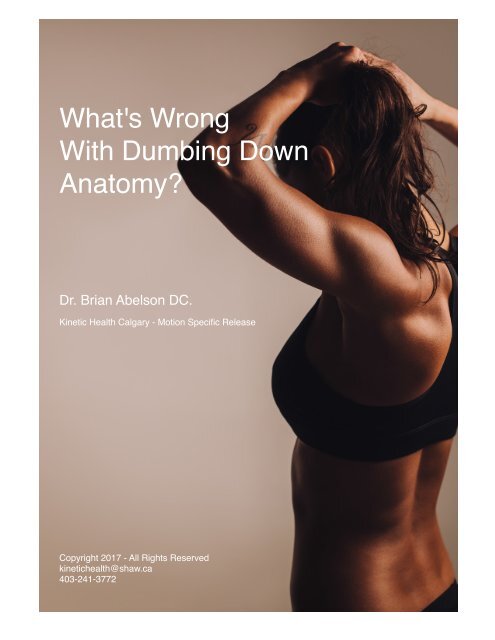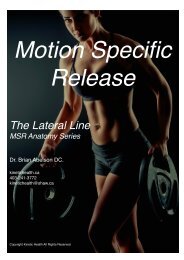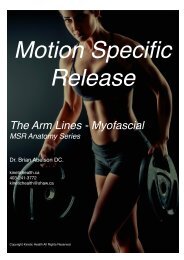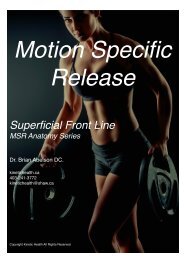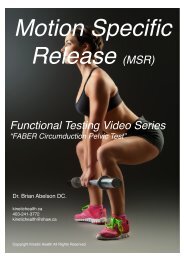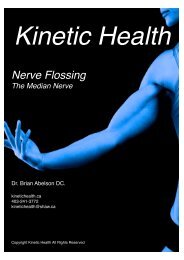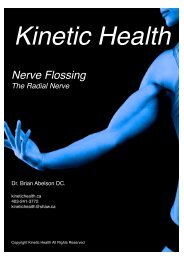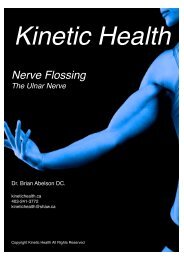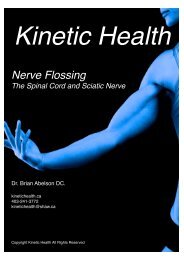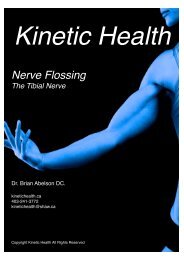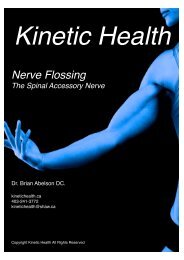WHAT’S WRONG WITH DUMBING DOWN ANATOMY?
The human body is an incredible, living, adaptive, self-communicating, always evolving machine that surpasses even our most advanced technological wonders. Unfortunately, this is not how standard anatomy classes are taught.
The human body is an incredible, living, adaptive, self-communicating, always evolving machine that surpasses even our most advanced technological wonders. Unfortunately, this is not how standard anatomy classes are taught.
Create successful ePaper yourself
Turn your PDF publications into a flip-book with our unique Google optimized e-Paper software.
What's Wrong<br />
With Dumbing Down<br />
Anatomy?<br />
Dr. Brian Abelson DC.<br />
Kinetic Health Calgary - Motion Specific Release<br />
Copyright 2017 - All Rights Reserved<br />
kinetichealth@shaw.ca<br />
403-241-3772
Dr. Brian J. Abelson DC<br />
403-241-3772 | kinetichealth@shaw.ca<br />
<strong>WHAT’S</strong> <strong>WRONG</strong> <strong>WITH</strong> <strong>DUMBING</strong><br />
<strong>DOWN</strong> <strong>ANATOMY</strong><br />
The human body is an incredible, living, adaptive, selfcommunicating,<br />
always evolving machine that surpasses even our<br />
most advanced technological wonders. Unfortunately, this is not<br />
how standard anatomy classes are taught. With in the medical<br />
educational system we are taught more about separate parts rather<br />
than totally integrated systems. Essentially we tend to<br />
compartmentalize everything as if they were somehow not part of a<br />
complete system. Essentially our education system "Dumbs Down"<br />
the human body to make it easier to teach students.<br />
My specialization is the treatment of musculoskeletal conditions. Over<br />
20 years ago when I first began my practice, I also looked at the body<br />
from this very limited perspective. Fortunately for my patients, my<br />
perspective has changed radically.<br />
You could say that three fundamental areas of knowledge have given<br />
me a personal epiphany on how our entire body works as one<br />
synergetic interconnected system. These are the myofascial system, the<br />
body's kinetic web, and the concept of tensegrity.<br />
About The Myofascial System<br />
[Type 403-241-3772 your address] [Type Kinetic your Health phone #34 number] Edgedale [Type Drive your NW, e-mail Calgary, address] Alberta, Canada<br />
BRIAN ABELSON<br />
The prefix 'Myo’' refers to muscle, whereas ‘fascia’ refers to the<br />
connective tissue that permeates the entire human body. Fascia is<br />
everywhere in the body, weaving through, and connecting every<br />
component of the body. Fascia forms a seamless web of connective<br />
tissue, which connects, holds, and infuses the tendons, organs,<br />
muscles, tissues, and skeletal structures.<br />
To get a better understanding of how interconnected we really are, it is<br />
essential that we first understand the significance of fascia. New<br />
discoveries over the last few decades have shown that fascia plays a<br />
very important role beyond that of simply serving as a packing material<br />
around muscles and organs. Fascia is intimately involved in controlling<br />
both the movement patterns and the neurological control mechanisms<br />
of the entire body. It is an integral component of a body-wide signalling<br />
system. Interestingly, it has been shown that fascia is full of
neurological receptors (even more so than muscle tissue). This is rather<br />
astounding, especially when of realizes that most physicians do not<br />
consider how fascia plays such a key role.<br />
Consider the image to the right, this is a dissection of the elbow<br />
(proximal lateral elbow region). What makes this dissection unique is<br />
that the muscles are dissected away from the body instead of the<br />
fascia. The strands you see show the convergence of this connective<br />
tissue to link all the structures surrounding the lateral elbow (lateral<br />
epicondlye). This is a great example of how convergence of multiple<br />
strands of connective tissue can form a interconnected functional<br />
matrix. If we did the same type of dissection technique in other areas<br />
of the body (shoulders, hips, knees etc.) we would discover a very<br />
similar pattern. Multiple stands of connective tissue, in complete<br />
continuity, with no visible separation from each other.<br />
Text book anatomy looks nothing like this. The anatomist's scalpel has<br />
removed all the fascia leaving the impression of individual muscles, all<br />
by themselves, each performing their own separate actions. Standard<br />
anatomy is actaully an anatomical fantasy, and a rather dumbed-down<br />
one at that!<br />
Image from "The Architecture of the Connective Tissue in the Musculoskeletal System—<br />
An Often Overlooked Functional Parameter as to Proprioception in the Locomotor
Apparatus - Jaap van der Wal, MD, PhD University Maastricht, Faculty of Health, Medicine<br />
and Life Sciences, Department of Anatomy and Embryology, Maastricht, Netherlands<br />
Muscle Contraction - How Things Really Work<br />
Standard texts for anatomy and biomechanics teach us that motion is<br />
created by the contraction of muscles. These muscles have tendons at<br />
each end that insert directly into bone. When a muscle contracts, the<br />
two ends of the muscle (origin and insertion) are pulled towards each<br />
other to create motion.<br />
Although this description is quite true, it is also a reductionist<br />
perspective about what is really happening in the body. Let me explain<br />
how an understanding of fascia can help us develop a new, more<br />
holistic perspective about how the body performs its actions. This will<br />
give us a better understanding about why looking at the bigger<br />
anatomical picture can help us to better resolve many complex<br />
musculoskeletal conditions.<br />
First, consider the fact that the muscle fibers actually originate from,<br />
and insert into, both the surrounding fascial fibers as well as the bone.<br />
These fascial fibers, in turn, insert into multiple regions of other bones,<br />
and even into other adjacent muscles. These additional points of<br />
contact provide muscles the ability to generate force in multiple<br />
directions (a three-dimensional model of movement).<br />
Learning about these multiple points of fascial attachment – all working<br />
across three-dimensions – completely changed my understanding of<br />
the biomechanics of muscle action, and also provides me with a much<br />
more functional understanding of muscle contraction. Now, when I look<br />
at, and analyze muscle contraction, I realize that only certain sections of<br />
the muscle contract to perform an action (not the entire muscle).<br />
In actuality, groups of muscles usually work together as functional units<br />
to execute any action. For example, some muscles may act as the<br />
primary movers (agonists) to perform an action, while other muscles act<br />
as antagonists; while yet others act as synergists and others as<br />
stabilizers. In all these activities fascia is the key component that allows<br />
these muscles to work together as functional units by aiding in<br />
coordinating their actions across multiple joints.<br />
Depending on the degree of motion, and the amount of force that is<br />
needed, each muscle will then contract very specific areas of the<br />
muscle, rather than the entire muscle. These very specific motions are<br />
largely coordinated by the neurological receptors embedded in the<br />
fascia, and are not controlled by the brain alone.
The Kinetic Web<br />
Your body is made up of a remarkable series of kinetically linked<br />
systems which, when working efficiently, store and release impressive<br />
amounts of energy without injury!<br />
Essentially, each body acts as a single large three-dimensional Kinetic<br />
Web, in which force or tension from one area directly affects multiple<br />
structures in both localized areas, and structures far from the site of<br />
tension.<br />
The Kinetic Web can be thought of as a linked series of kinetic chains.<br />
Each kinetic chain is made up of individual links (the various<br />
components of your musculoskeletal system, nervous system, and<br />
cardiovascular system) which are connected to each other to form a<br />
three-dimensional Kinetic Web. When you have changes in one area of<br />
your body, there will be cascading effects throughout the entire body,<br />
and thus multiple structures in your kinetic web will be affected.<br />
Any weak link in this chain not only generates its own set of problems,<br />
but also creates problems and compensations somewhere else in the<br />
body. For example, when a structure in your hip, groin, or pelvis is<br />
injured or restricted, it becomes unable to effectively perform its normal<br />
functions such as walking, climbing up stairs, or even being intimate<br />
with your significant other.<br />
Kinetic Lines<br />
Kinetic Lines (whole body fascial interconnections) are actual physical<br />
structures that have been mapped out and dissected. These are actual<br />
physical structures that connect our bodies together. Researchers and<br />
clinicians such as Thomas Myers (Anatomy Trains), Luigi, Carla and<br />
Antonio Stecco (Fascial Manipulation) have spent decades researching<br />
these interconnections.<br />
Think of these Kinetic Lines as vectors for force transmission, they are<br />
not only connections, but are also a continuous line of tension. In the<br />
case of Thomas Myers, he has mapped out seven primary lines of<br />
fascial connection throughout the body. These are the:<br />
• Superficial Back Line (SBL).<br />
• Superficial Front Line (SFL).<br />
• Lateral Line (LL).
• Spiral Line (SL).<br />
• Arm Lines.<br />
• Functional Lines.<br />
• Deep Front Line (DFL).<br />
Other researches have mapped out slightly different connections, but<br />
the general concepts remain very similar. For example let us consider<br />
the Superficial Back Line (SBL).<br />
Tensegrity – Tension Plus Integrity<br />
A key concept in understanding your body as an interconnected kinetic<br />
web is known as ‘Tensegrity’. Tensegrity is a structural principle that<br />
describes the integrity of a structure based on the balance of tensional<br />
forces rather than just its compressive nature.<br />
First a little history; the term 'Tensegrity' was made popular in the<br />
1960’s by a neo-futuristic architect by the name of Richard<br />
Buckminister “Bucky” Fuller (1895-1983). Fuller came up with this term<br />
when examining the highly creative sculptures of Kenneth Snelson.<br />
Snelson’s sculptural works are composed of both flexible and rigid<br />
components. Snelson uses the term ‘floating compression’ instead of<br />
‘tensegrity’ to describe his sculptures.<br />
The geodesic dome is a superb example of an architectural structure<br />
that uses the concepts of tensegrity. Due to its structure, the geodesic<br />
dome is an incredibly stable building due to all the pressure being<br />
distributed throughout the entire framework. I remember my sense of<br />
awe and wonder when I saw my first geodesic dome as a child at the<br />
1967 World's Fair in Montreal (The Biosphere). Even then, I and many<br />
other, knew that we were looking at something special!<br />
With regards to how tensegrity relates to the human body, I will refer to<br />
an analogy used by Thomas Myers of Anatomy Trains. Standard<br />
anatomical perspectives teach that our skeleton provides a strong<br />
stable framework to support the array of soft tissue structures that are<br />
attach to it. This is a concept of ‘continuous compression’ in which the<br />
osseous structure of the body provides structural integrity.<br />
This is the same concept we use when building skyscrapers, where<br />
each layer of the building provides support for the next layer, and is<br />
built on a strong base of stability (a Linear Model). The problem when<br />
applying this concept to our human body is that this is a static model<br />
(not reality). Yes “continuous compression” works well in building<br />
construction, but not so well in explaining the structural integrity of<br />
dynamic human bodies that are in continual motion.
Think about this, without the muscles, ligaments, tendons, and<br />
connective tissue, the framework (our skeleton) would simply collapse.<br />
Thomas Meyers uses the analogy of a sailboat to describe this<br />
concept. He compares the mast of the boat to our skeletal system and<br />
its rigging to our myofascial system. When the wind catches the sail of<br />
a boat it directs an incredible force into the mast, yet the mast does not<br />
come toppling down because of the tensional balance of its rigging.<br />
When one side of the rigging becomes tight and contracted, while the<br />
rigging on the other side of the boat becomes loose and movable. That<br />
is, until the wind changes and the sail is then pushing in another<br />
direction which requires the line of tension to shift to the other side.<br />
This describes a dynamic system where a rigid structure (the mast) can<br />
take on dynamic qualities because of it tensional system (its rigging).<br />
In the same way, our skeletal system maintains its integrity due to the<br />
balance of tensional forces provided by our myofascial system. We can<br />
run, jump, move, take our bodies into a thousand contorted positions,<br />
and return to a state of balance all because of this concept of<br />
tensegrity.<br />
Tensegrity and Injury Resolution<br />
The greatest thing about understanding how our body is totally<br />
connected is the how this information helps resolve even some of the<br />
most chronic injuries. Consider this analogy.<br />
Consider how a soft pliable ball reacts to compressive forces. An<br />
interesting thing occurs when we take a ball that is about seven inches<br />
in diameter (like the ones we use for myofascial release of the<br />
abdomen), and compress it with our hands.<br />
When we grasp the ball and squeeze hard, the area that we are<br />
squeezing contracts while the rest of the ball expands. If we then take<br />
some type of mechanical device and squeeze even harder until the ball<br />
bursts, we would find the area of rupture in the ball is the weakest part<br />
of the material. Interestingly, the point of rupture is often located far<br />
from the point of applied force.<br />
The same thing occurs in the human body. Previous injuries, muscle<br />
imbalances, lack of exercise, mental stress (anxiety), poor nutrition, and<br />
a host of other problems all create weak links in your body’s kinetic<br />
chain. These are areas where the body is most susceptible to injury.<br />
When increased stress is applied to the body, the entire body tries to<br />
compensate. If the weakest link cannot withstand this additional<br />
stress, then an injury occurs at that link.
This tells us that we not only have to consider where the body has<br />
developed weak links, but we also have to consider the nonsymptomatic<br />
areas that are creating this increased stress. Often, these<br />
are areas where the patient is not even aware that there is any problem.<br />
The Critical Key<br />
Tensegrity is the key to resolving most chronic musculoskeletal injuries.<br />
We must “Look local and Look global”. If there is a problem, we must<br />
address both local and global areas. Treatments that only address the<br />
symptomatic region (the area of pain) are really an equation for failure.<br />
Bottom line, we are so much more than what appears on the two<br />
dimensional pages of an anatomy text (the dumbed-down version). We<br />
are complex three-dimensional beings that work as one synergistic<br />
organism. Recognizing this gives us the path to true healing, ignoring<br />
this leads us down the path to ongoing dysfunction.<br />
.
SOCIAL MEDIA PRESENCE<br />
You can find Dr. Abelson across all types of social media.<br />
As of March 2017, Dr. Abelson had over 51,295 dedicated subscribers,<br />
friends,<br />
and followers across his various social-media platforms.<br />
YouTube – 34, 072 subscribers.<br />
• Over 8 million views.<br />
• 450 exercise, biomechanics, anatomy, and MSK<br />
treatment videos.<br />
Facebook – 6562 friends and followers.<br />
Linked In – 3528 health and wellness related practitioners<br />
and business contacts.<br />
Twitter – 7133 followers.


